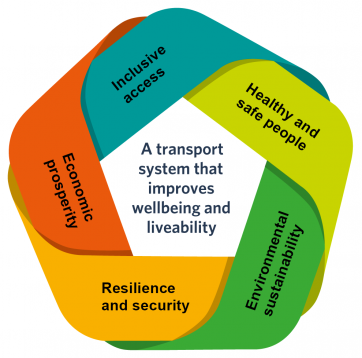The Transport Outcomes Framework
In 2018, the Ministry of Transport published the Transport Outcomes Framework (the Framework). Government transport agencies are expected to set out how they will individually and collectively contribute to the outcomes of the Framework. The Framework is intended to set out the broader social and economic outcomes that are influenced by transport policy and investment decisions.
The Framework does not identify which outcomes the Government should choose to focus on, or how the Government will achieve those outcomes (for example, what are the strategies, plans, and specific policy interventions the Government intends to use to achieve a given outcome).

| Inclusive access | Enabling all people to participate in society through access to social and economic opportunities, such as work, education, and healthcare. |
| Healthy and safe people | Protecting people from transport-related injuries and harmful pollution and making active travel an attractive option. |
| Environmental sustainability | Transitioning to net zero carbon emissions and maintaining or improving biodiversity, water quality, and air quality. |
| Resilience and security | Minimising and managing the risks from natural and human-made hazards, anticipating and adapting to emerging threats, and recovering effectively from disruptive events. |
| Economic prosperity | Supporting economic activity via local, regional, and international connections, with efficient movements of people and products. |
Source: Ministry of Transport's Transport Outcomes Framework at transport.govt.nz.
Broader government outcomes
The Framework overlaps and contributes to outcomes across the public sector. Therefore, this requires the transport sector to work with other sectors for a joined-up approach to achieving these outcomes.
The outcomes in the Transport Outcomes Framework align with the four capitals of the Treasury’s Living Standards Framework.
Transport indicators
The Ministry of Transport uses 37 indicators to measure and report on progress against the five outcomes in the Framework.
Under each outcome there are specific “themes”, which have several indicators that enable a detailed assessment of the outcomes.
The transport indicators were last updated in May 2022. The Ministry of Transport recognises that the indicators need to be updated, particularly to address environmental sustainability and resilience. The Ministry intends to update the indicators on an iterative basis. However, it is unclear when the updates will start.
Clear information is available about the reporting requirements, data sources, and limitations for the indicators that agencies are responsible for.
Our assessment
The transport sector is advanced at setting out outcomes that it can influence and be held to account for its performance.
In general, the indicators are comprehensive and appropriate for measuring the Framework’s outcomes. The outcomes (for example, the number of transport-related deaths and serious injuries in relation to understanding the road toll) are also relevant to the interests of Parliament and the public – the readers of this information.
The Ministry of Transport provides accessible reporting on the transport indicators on its website. This reporting provides a high-level view on what progress is being made on what the sector is seeking to achieve in the longer-term.
This reporting has useful infographics that show trend information on the indicators. However, the reporting could be improved by including more timely reporting and commentary and analysis on how to interpret the performance information.
The Ministry of Transport reports on some of the indicators in its annual report, which are focused on understanding how the system is performing and to help identify where further policy work is needed.
However, this reporting is not clearly connected to its performance story, strategic intentions, or how it is fulfilling its responsibilities as steward of the transport sector.
Māori continue to experience inequities in transport outcomes, including difficulties accessing transport for critical services (for example, GP services) and being overrepresented in road-related serious injuries and fatalities.
The quality and availability of reporting on how the transport sector is serving and performing for Māori is important for public accountability. The Framework misses an opportunity, in that it does not reflect outcomes and indicators that are important to Māori. An outcomes framework should have outcomes that are important to Māori and describe how the sector will achieve these outcomes.
The Ministry of Transport plans to update the Framework to better reflect Māori aspirations and te Tiriti o Waitangi. The Ministry is also working on improving outcomes for Māori in the transport system (He Waka Maiangi). This work is in early stages of development, but is a positive step.


